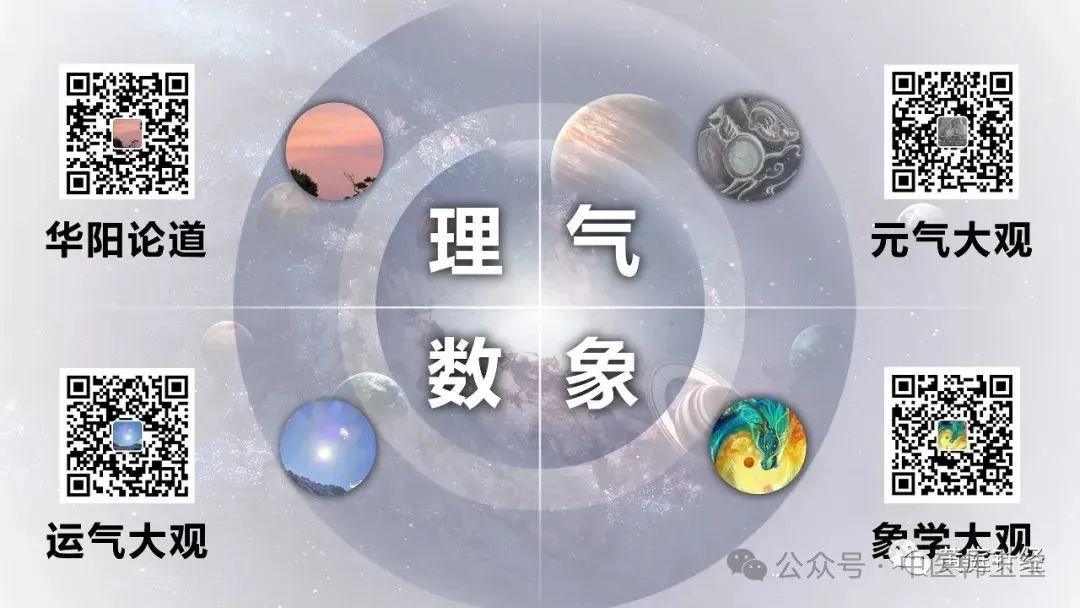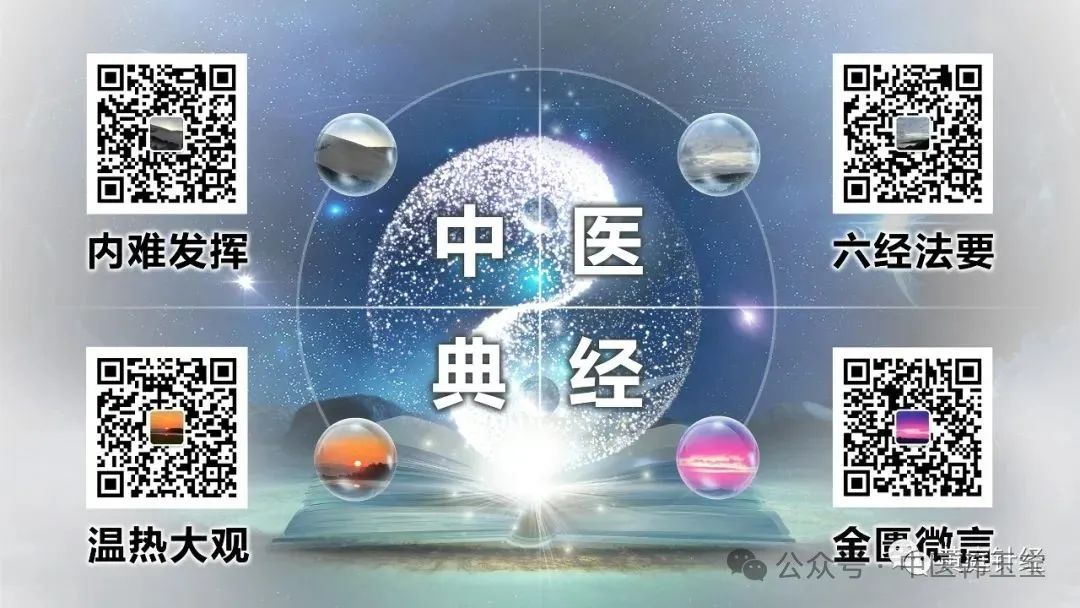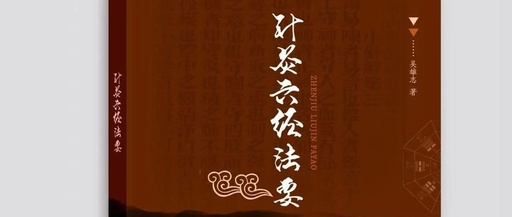“ In the Eight Gates and Six Harmonies system, there are only a few components: the first is called meridians, the twelve regular meridians and twelve extraordinary meridians. The second is called collateral meridians, and the third is called sinews, consisting only of meridians, collaterals, sinews, and lines.”
Part One
Volume Two: Meridian Studies
Chapter Two: Wu Men Collaterals
The “Ling Shu: Jing Bie” states, “The foot Shao Yang channel encircles the hip and enters the hairline, connecting with the Jue Yin.”
Is this connection with Jue Yin considered a branch line connecting Shao Yang and Jue Yin?
Does this channel differ from the collateral meridian in being slightly thicker, or does it have more abundant Qi and blood energy?
It is important to note that the Eight Gates and Six Harmonies system does not include Jing Bie.
In the Eight Gates and Six Harmonies system, there are only a few components:
The first is called meridians, the twelve regular meridians and twelve extraordinary meridians;
The second is called collateral meridians;
The third is called sinews, which includes one more meridian than traditional acupuncture.
What is a meridian line?
A meridian line is a segment of a meridian with similar functions, often located on the same meridian or across different meridians. It has similar functions in close proximity, thus termed a meridian line.
In our system, there is no Jing Bie; Jing Bie is classified under collateral meridians, making this classification simple, direct, clear, and understandable.
Section One: Tai Yang Meridian
1. Hand Tai Yang Meridian
The special point Tai Yang is located on the side of the head, half an inch (Tai Yang Er) or one inch (Tai Yang Yi) behind the midpoint between the eyebrow tip and the outer corner of the eye.Si Zhu Kong, Tong Zi Liao, Tai Yang points are in the same disturbance field, all treating eye diseases.
Thus, the Hand Tai Yang Meridian does not end at the Ting Gong point, but extends from Ting Gong to Tai Yang, connecting to Tong Zi Liao.
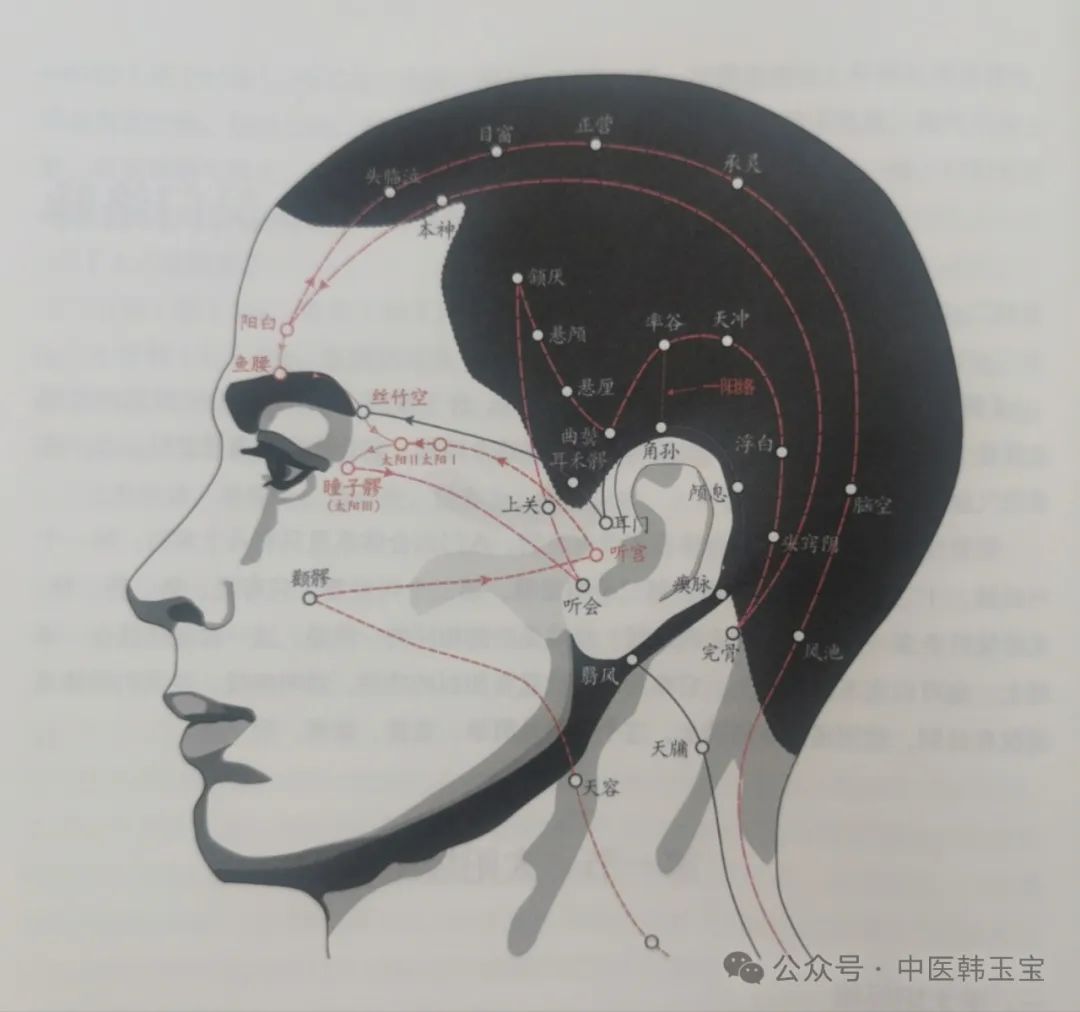 |
2. Foot Tai Yang Meridian
The “Ling Shu: Jing Mai” states: “The Bladder channel of the foot Tai Yang begins at the inner canthus of the eye, ascends to the forehead, and intersects at the vertex;
Its branch extends from the vertex to the upper corner of the ear;
The main channel enters the brain, exits below the neck, follows the shoulder, and runs along the spine to the waist, entering the lumbar region, connecting to the kidneys and belonging to the bladder;
Its branch descends from the waist, runs along the spine, penetrates the buttocks, and enters the popliteal fossa;
Its branch runs from the shoulder, diverges to the left and right, penetrates the scapula, runs along the spine, passes through the hip joint, follows the outer back of the hip down to the Yao Zhong, and descends to the inner ankle, exiting behind the outer ankle, following the fifth metatarsal bone to the outer side of the little toe.“
The foot Tai Yang Bladder channel runs alongside the spine, through the buttocks to the Yao Zhong, reaching the Wei Zhong.
Another branch runs through the Zhi Bian (located at the lower edge of the piriformis muscle, laterally adjacent to the sciatic nerve, which is often compressed by the piriformis muscle, causing pain), connects to the Huan Tiao point, and descends along the outer thigh to the foot Shao Yang Gallbladder channel, descending to the Fu Xie and Wei Yang (Fu Xie and Wei Yang connect to the Shao Yang channel at Huan Tiao, thus these two points connect to the Shao Yang channel), converging at Wei Zhong.
It descends through the gastrocnemius (He Yang, Cheng Jin, Cheng Shan), exits behind the outer ankle (Fei Yang, Fu Yang, Kun Lun), along the fifth metatarsal bone (Pu Shen, Shen Mai, Jin Men, Jing Gu), reaching the outer side of the little toe (Shu Gu, Zu Tong Gu, Zhi Yin), and connects to the foot Shao Yin Kidney channel.
 |
 |
 |
The Huan Tiao point is located above the sciatic nerve, which runs from the Yin Men point down to the Wei Zhong, known as the tibial nerve. Therefore, Zhi Bian – Huan Tiao – Yin Men – Wei Zhong are four points connected by meridians (i.e., Huan Tiao – Yin Men collateral, whose physiological basis is related to the sciatic nerve), which is also the mechanism for treating low back pain with these four points.
The Bladder channel in the thigh consists of two parallel lines that do not cross:
One is Hui Yang – Cheng Fu – Yin Men – Wei Zhong;
The other is Zhi Bian – Huan Tiao – Fu Xie – Wei Yang, which again converges at Wei Zhong.
Thus, the Bladder channel runs parallel along the back and legs, connecting above at Tian Zhu and below at Wei Zhong. Meanwhile, the Huan Tiao – Yin Men collateral is also connected.
The common peroneal nerve branches off from the sciatic nerve at the upper corner of the popliteal fossa, running along the inner edge of the biceps femoris (Wei Yang) downward, passing behind the head of the fibula and wrapping around the neck of the fibula, closely adhering to the periosteum before entering the gastrocnemius muscle, where it divides into the superficial and deep peroneal nerves.
The superficial peroneal nerve descends to the front of the outer ankle (running along with the foot Shao Yang channel), reaching the dorsum of the foot. One branch runs behind the outer ankle (running along with the foot Bladder channel).
The gastrocnemius nerve is composed of the skin branches from the tibial nerve’s inner side and the outer skin branches from the common peroneal nerve, descending along the midline of the calf to the back of the outer ankle, innervating the skin of the dorsum of the foot and the outer edge of the little toe (Zhi Yin – Shen Mai).
The deep peroneal nerve emerges between the first and second toes, innervating this area (foot Jue Yin Liver channel Da Dun / Du Yin – Xing Jian – Tai Chong).
Thus, Yang Ling Quan is a point that connects the Tai Yang, Shao Yang, and Jue Yin channels.
There should be a collateral connection between the Wei Yang point and Yang Ling Quan (Wei Yang collateral), which is also the anatomical basis for Wei Yang connecting to the Shao Yang channel.
The “Ling Shu” states: “For San Jiao disease, abdominal Qi is full, especially the lower abdomen is hard and unable to urinate, urgent, and if overflowing, water remains, which is distension, located outside the foot Tai Yang, the large collateral is between Tai Yang and Shao Yang, also seen in the pulse, take Wei Yang.”
Below the Wei Zhong point is the tibial nerve, which is a continuation of the sciatic nerve trunk, descending alongside the posterior surface of the soleus muscle with the posterior tibial artery (running along with the foot Tai Yang channel), wrapping around the inner ankle, dividing into the lateral and medial plantar nerves.
Its muscular branches innervate the posterior group of the calf muscles and all muscles of the foot;
its cutaneous branches distribute to the lower posterior part of the calf, the sole, and the outer edge of the little toe.
The Fu Liu point is located below the soleus muscle, where the tibial nerve is distributed. The Fu Yang point is located behind the fibula, at the anterior edge of the Achilles tendon, where the tibial nerve passes, thus there should be a collateral connection between Fu Yang and Fu Liu (Fu Yang – Fu Liu collateral), linking the foot Tai Yang Bladder channel with the foot Shao Yin Kidney channel, which is also the anatomical basis for Fu Liu distributing water and fluids, sweating, and returning Yang.
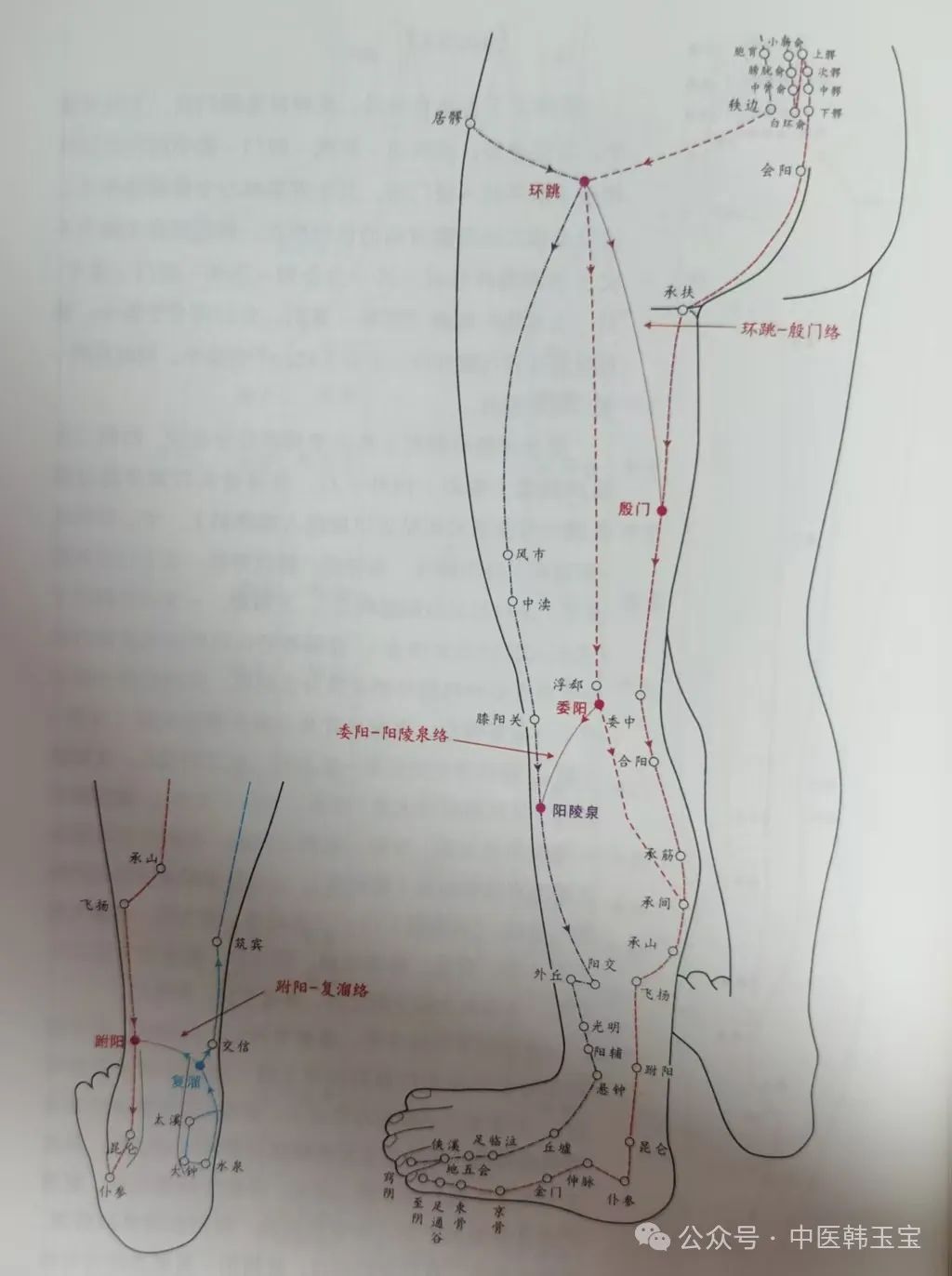 |
The Huan Tiao – Yin Men collateral (which runs along with the sciatic nerve) connects with the Wei Yang – Yang Ling Quan collateral (which connects with the peroneal nerve) linking the Shao Yang and Tai Yang, Fu Yang – Fu Liu collateral (which connects with the tibial nerve) links Tai Yang and Shao Yin, the aforementioned three collaterals create complex functional interactions between the Tai Yang, Shao Yang, and Shao Yin channels.
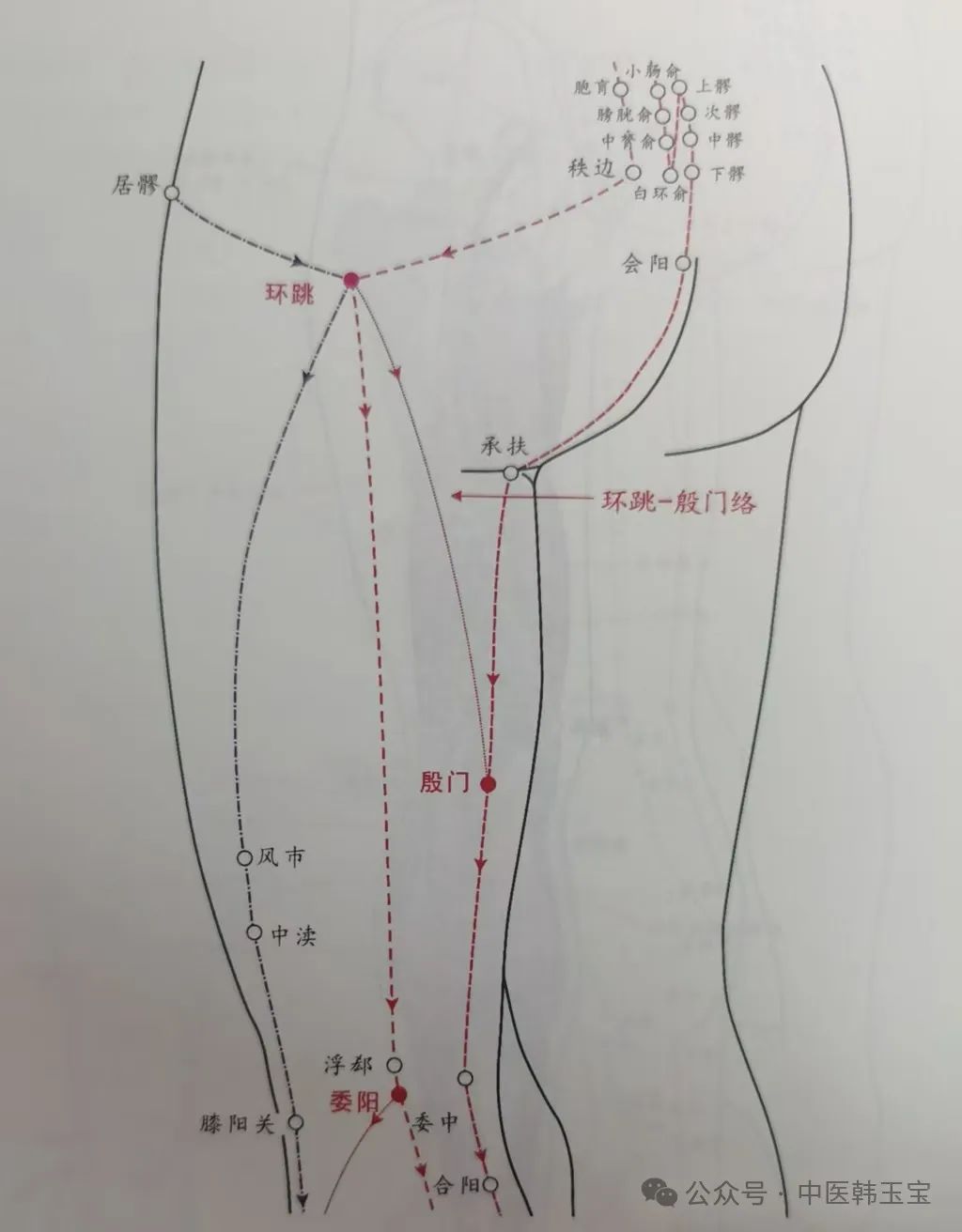 |
The Huan Tiao point connects above to the Shao Yang Ju Liao, and below to the Shao Yang Feng Shi, and the Tai Yang Fu Xie. Huan Tiao is centrally located like a ring, symmetrical up and down, left and right, hence the name Huan Tiao.
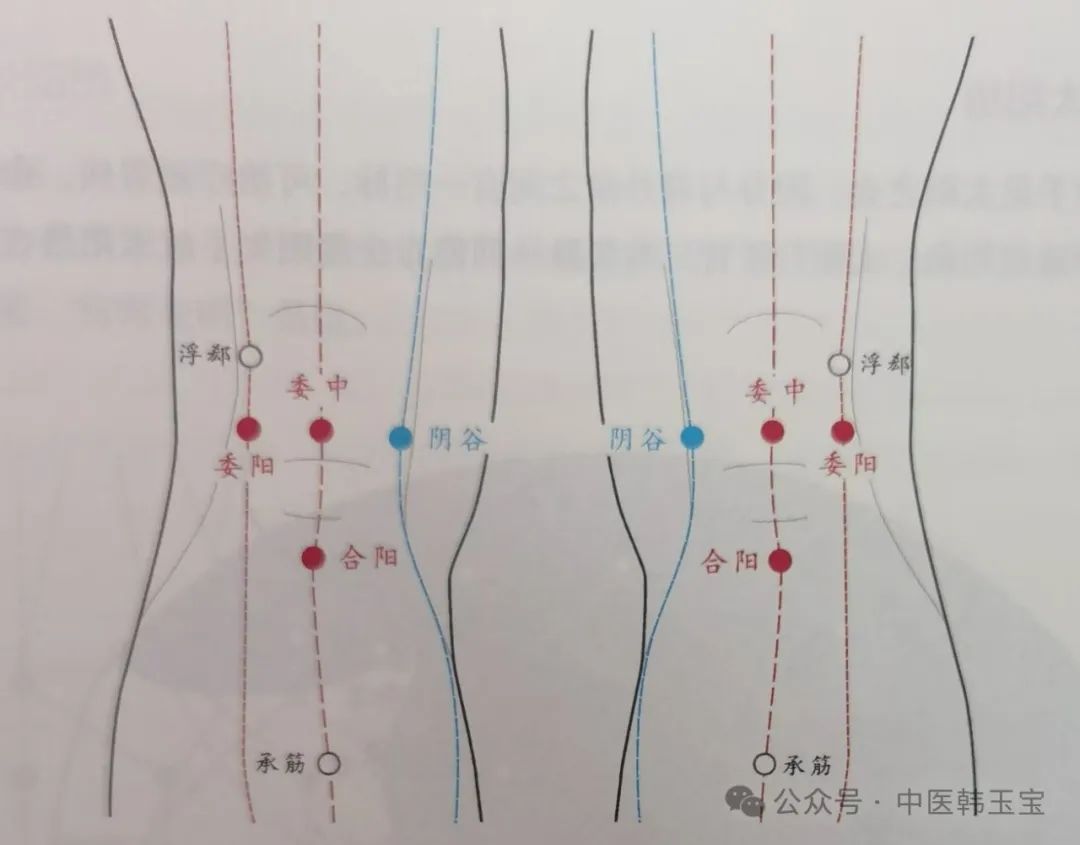 |
The Four Kidney Points are centrally located at Wei Zhong, outside Wei Yang, inside Yin Gu, and below He Yang.
Wei Zhong, Wei Yang, and He Yang are all on the Tai Yang channel, while Yin Gu is on the Shao Yin channel, serving as a connecting point, belonging to water. Wei Yang is between the Shao Yang and Tai Yang channels, serving as a lower connecting point for the San Jiao.
All four points treat symptoms such as difficulty urinating and low back pain.
Among them, Wei Yang connects to the San Jiao channel, serving as a specific point for difficulty urinating. Wei Zhong is a specific point for low back pain. Wei Yang treats metrorrhagia and also treats testicular inflammation in men. Yin Gu treats Kidney Yin deficiency and also treats metrorrhagia.
One inch above Wei Yang is Fu Xie, which treats vomiting, diarrhea, cramps, and constipation. This point is in the same disturbance field as Wei Yang; the author has experienced that both points connect to the Hand Shao Yang San Jiao channel.
The “Shang Han Lun” states: “For Yang Ming disease, if there is hardness and fullness under the ribs, no bowel movement and vomiting, with a white coating on the tongue, Xiao Chai Hu Tang can be administered. If the upper Jiao is unblocked, the fluids will descend, the stomach Qi will harmonize, and the body will sweat and resolve.” This can be summarized in one sentence.
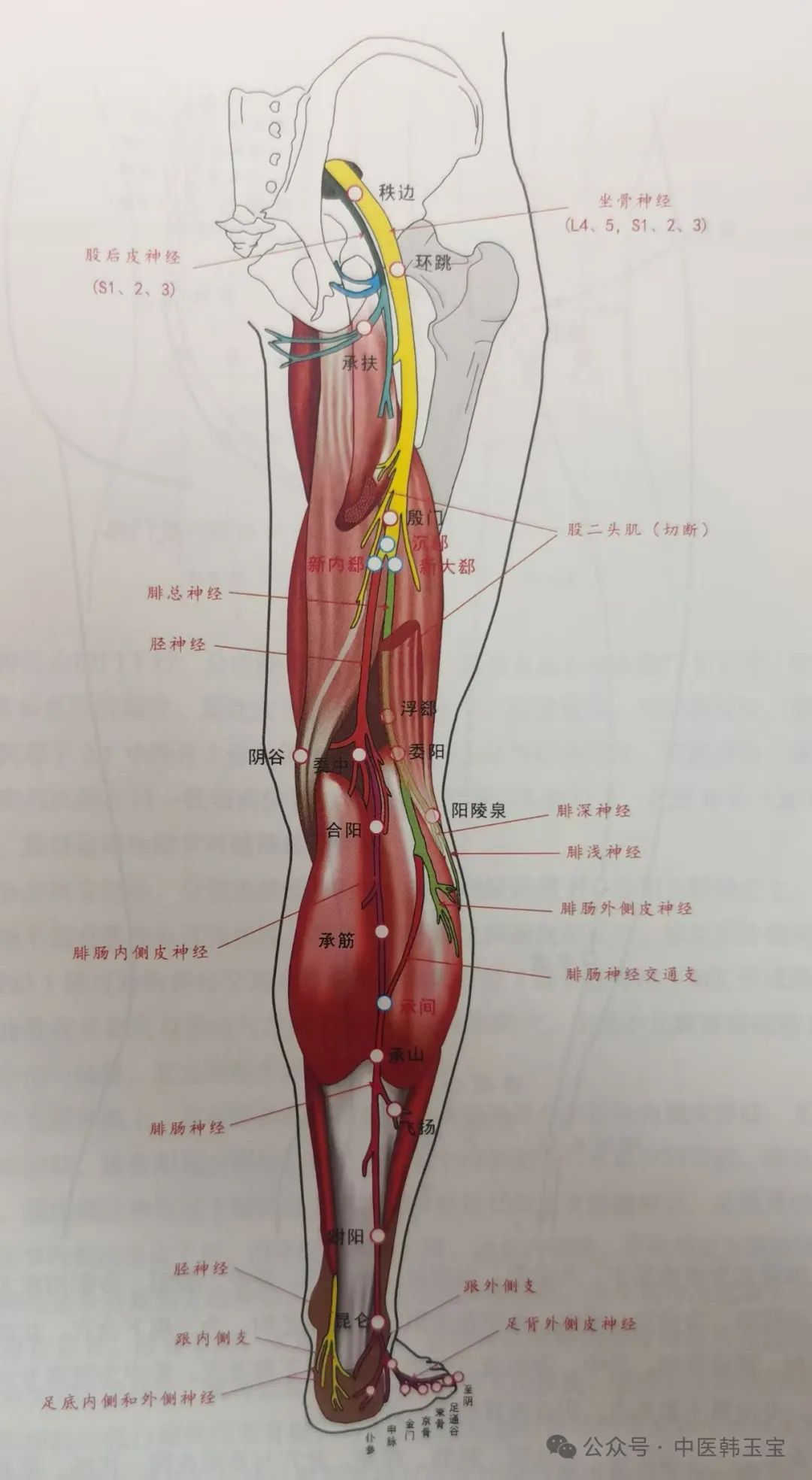 |
The sciatic nerve descends from the Yin Men, branching into the tibial nerve and peroneal nerve, with the branching points generally located one inch below the Yin Men and one inch above the Feng Shi, which the author names Chen Xie point, as this point is located beneath the long head of the biceps femoris, relatively deep, corresponding to Fu Xie.
Dr. Guo Cai determined that 0.5 inches below Chen Xie, 5 fen outward is Xin Da Xie point, and 5 fen inward is Xin Nei Xie point, which are the starting points of the tibial nerve and peroneal nerve, indeed located in the same disturbance field as Chen Xie but positioned more superficially.
Due to compression from the biceps femoris, this area is prone to Qi and blood stagnation, forming nodules; local positive nodules can assist in diagnosing tumors.
Chen Xie branches into two meridians, running towards Fu Xie and Wei Zhong.
Wei Zhong is above the tibial nerve, while Wei Yang is above the peroneal nerve.
There should not be a direct connection between Wei Zhong and Wei Yang through the Bladder channel; rather, the connection should be between Wei Yang and Cheng Shan through the Bladder channel.
The lateral cutaneous nerve of the calf (originating from the peroneal nerve) connects with the medial cutaneous nerve of the calf (originating from the tibial nerve) through the peroneal nerve’s communicating branches, forming the gastrocnemius nerve, with the junction located between the Cheng Jin and Cheng Shan points (i.e., the extraordinary point Cheng Jian, which treats sequelae of polio).
Thus, Wei Yang point indeed branches out a collateral, connecting the Tai Yang channel at the Cheng Jian point (Cheng Yang collateral).
The He Yang point is located above the tibial nerve, innervated by the medial cutaneous nerve of the gastrocnemius muscle. The tibial nerve branches into the medial cutaneous nerve, with the innervation area connecting with the saphenous nerve, thus He Yang connects to the Shao Yin channel, capable of warming the kidneys.
The medial side of Wei Zhong, the Yin Gu point, is on the foot Shao Yin Kidney channel, innervated by the medial cutaneous nerve of the thigh. The medial cutaneous nerve belongs to the branches of the femoral nerve, with the longest cutaneous branch being the saphenous nerve, which is the terminal branch of the femoral nerve, emerging subcutaneously on the inner side of the knee joint, descending along the inner side of the calf to the inner edge of the foot, running along with the foot Shao Yin channel.
The sciatic nerve is the largest nerve in the body, composed of lumbar and sacral nerves. Due to its different nerve origins, there are differences in its innervation areas, hence the distinctions between the Shao Yang and Tai Yang channels.
For example, the sciatic nerve originating from the lumbar nerves can innervate the hepatic flexure of the colon, exhibiting characteristics of the Shao Yang channel;
while the sciatic nerve originating from the sacral nerves can innervate the bladder, exhibiting characteristics of the Tai Yang channel.
The pathway of the foot Tai Yang Bladder channel has historically been questioned, and the relationship with the foot Shao Yang Gallbladder channel has also been less explored. The author proposes a new perspective on the pathway of the Bladder channel based on personal experience and modern medical neuroanatomy, which is merely one opinion for reference. Scholars can integrate various perspectives and make their own choices.
3. Hand and Foot Tai Yang Collaterals
The Fu Fen point is the meeting point of the Hand and Foot Tai Yang, and there is a collateral meridian between Fu Fen and the Shoulder Wai Yu, which can treat neck and shoulder diseases, hence named Tai Yang collateral, which can Fu Fen penetrate the Shoulder Wai Yu.
The Tai Yang runs along the back, distributing the Shao Yin and Yang Qi together with the Du Meridian, thus the Tai Yang collateral is located on the back, extending vertically above.
 |
4. Tai Yang and Shao Yang Collaterals
1. Tong Yang Collateral
The Tong Zi Liao point is the meeting point of the foot Shao Yang and hand Tai Yang, with a collateral meridian connecting to the Tai Yang point (Tong Zi Liao – Tai Yang – Ting Gong). The saying goes, “the seven orifices are interconnected, each orifice is bright.”“
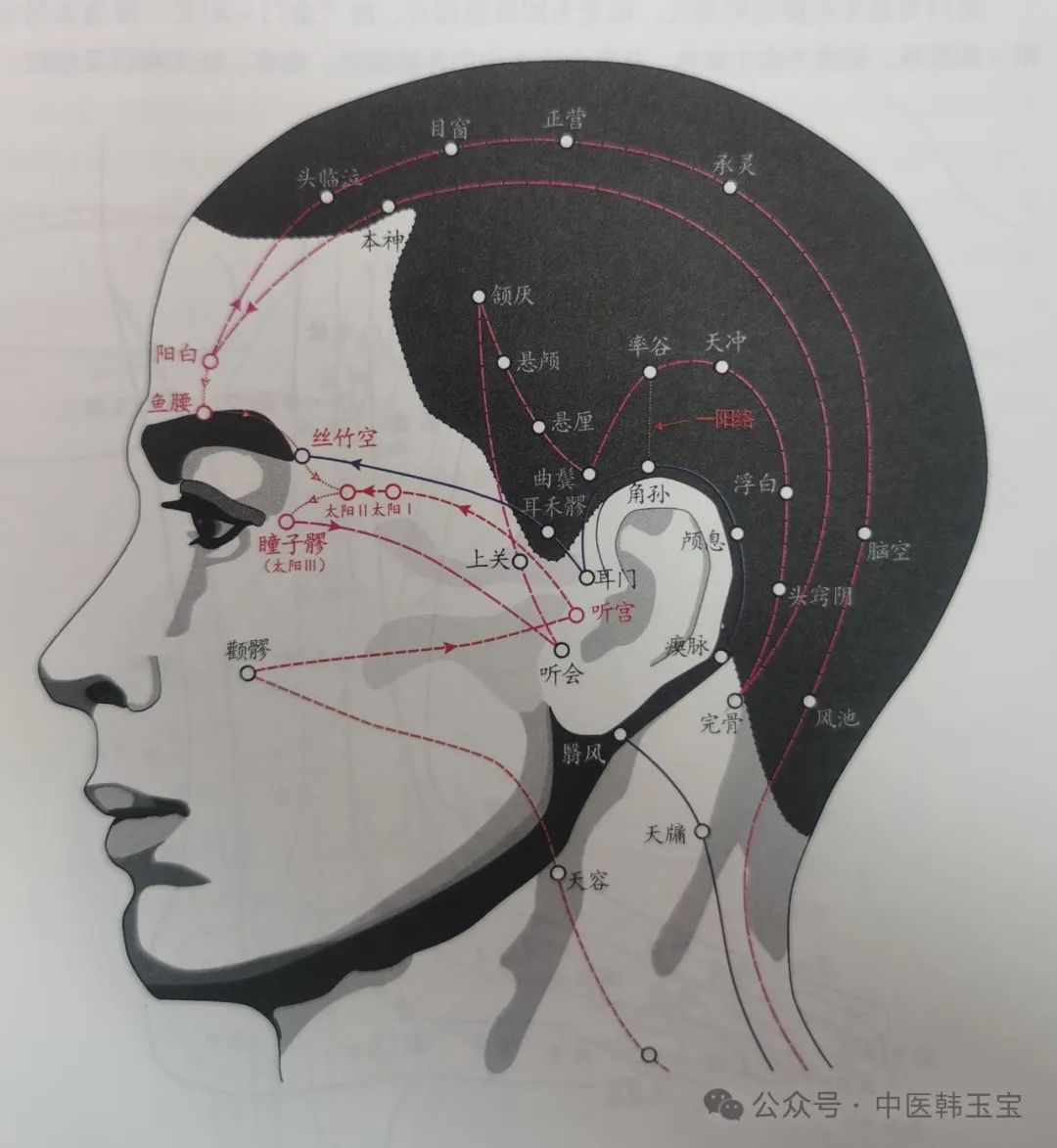 |
2. Jin Men Collateral
The Yang Wei begins at the Jin Men point of the foot Tai Yang Bladder channel, where Jin means shield, thus it is the beginning of the Yang Wei. It ascends to Qiu Xu, intersects with the foot Shao Yang, and runs along the foot Shao Yang Gallbladder channel seven inches above the outer ankle to the Yang Jiao point.
The “Shang Han Lun” states: “For cold damage or wind stroke, if there is a Chai Hu syndrome, just one symptom is sufficient, and it is not necessary to have all symptoms.”
Qiu Xu is the source point of the Gallbladder channel, treating gallbladder diseases. Xiao Chai Hu Tang treats cholecystitis and also treats Tai Yang external pathogens. The segment “Jin Men – Yang Jiao” of the Yang Wei channel is the collateral of Tai Yang and Shao Yang.
Jin Men is the Xi point of the foot Tai Yang Bladder channel, while Yang Jiao is the Xi point of the Yang Wei channel, thus the segment “Jin Men – Yang Jiao” is the collateral of Tai Yang – Shao Yang – Yang Wei. Yang Wei is associated with cold and heat diseases, thus the Yang Jiao point is indicated for Shao Yang external damp-heat, herpes, rabies, and mania.
 |
3. Fei Xue Collateral
The Jing Men point belongs to the foot Shao Yang Gallbladder channel, also known as Qi Fu, Qi Yu, and is the Mu point of the Kidney. Because the Jing Men point ascends to connect with the Sun and Moon, and descends to connect with the Dai Mai, Wu Shu, and Wei Dao, it is named the “Fei Xue” point.
The Jing Men point is located on the lateral side of the waist, 1.8 inches behind the Zhang Men, below the free end of the twelfth rib. The Jing Men point runs down the Gallbladder channel to the Dai Mai point.
However, the Jing Men point branches out a collateral meridian connecting to the Kidney Shu. The Jing Men point is prone to stagnation, and one can tap the Jing Men to open the pathways between the Sun and Moon and the Kidney Shu. This is called “Fei Xue running Qi,” which belongs to the method of thunder and fire, and can exert a kidney-tonifying effect.
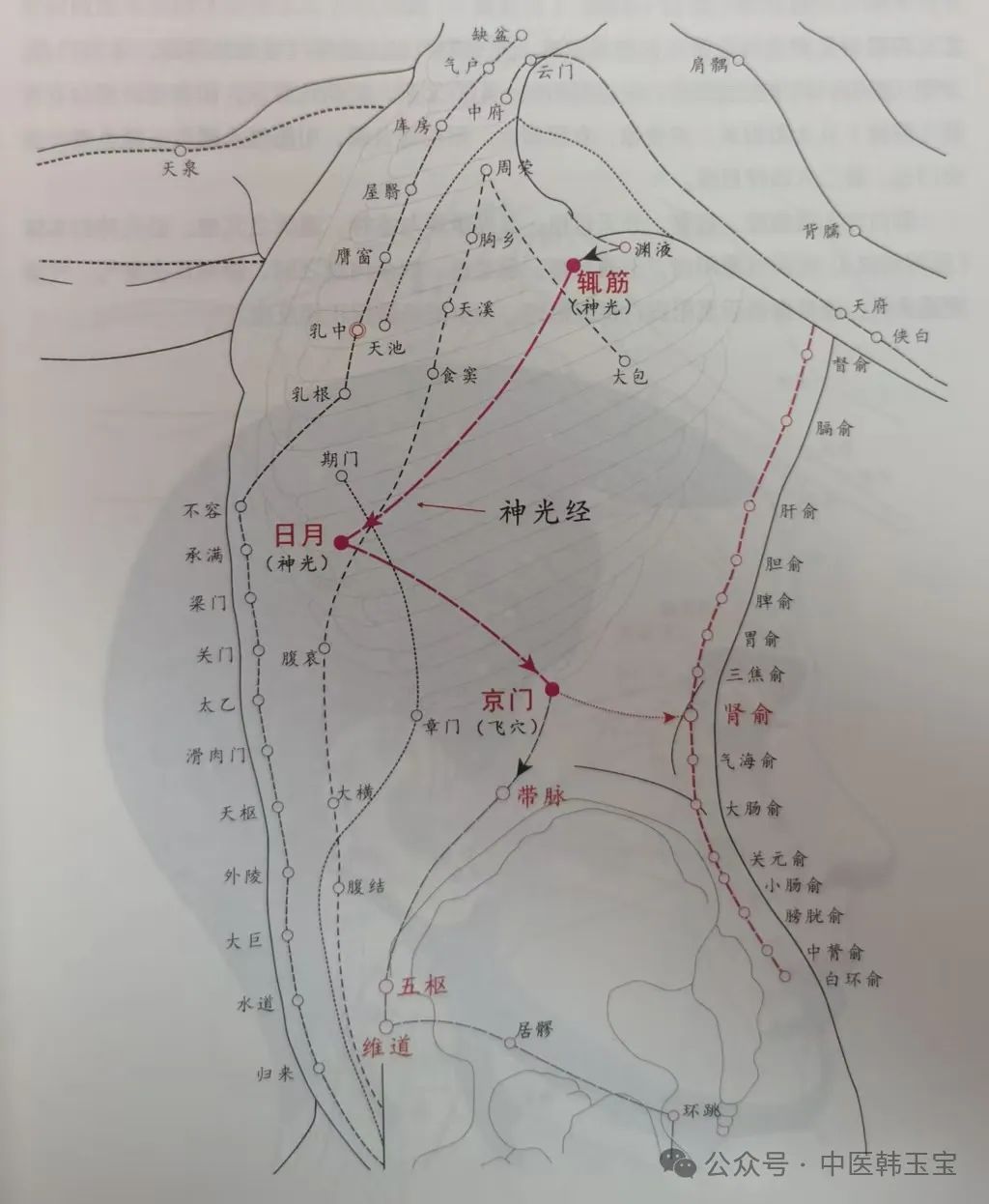 |
Copyright Statement
This article is excerpted from “Essentials of Acupuncture Six Meridians,” authored by Wu Xiong Zhi, published by China Traditional Chinese Medicine Press, November 2024, First Edition.
The content of this article is for clinical thought reference only. Sharing this article is for the purpose of dissemination and learning exchange, and does not take responsibility for the views expressed in the article, for reference only. This article does not recommend any medications or treatment methods; non-professionals should not self-diagnose or blindly try medications. If there are any discomforts, please seek medical attention offline. If there is any infringement, please contact us (hanyubao0927) for deletion.

Meridian Studies I: Wu Men Meridian and Hand and Foot Six Meridians
Meridian Studies I: Wu Men Meridian and Eight Extraordinary Meridians
Essentials of Acupuncture Six Meridians I Table of Contents (hyperlink)
